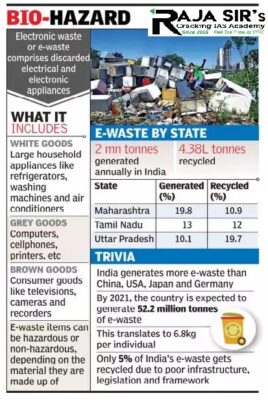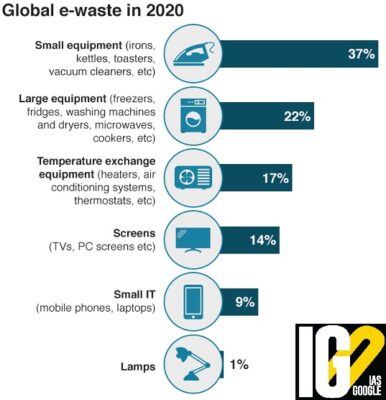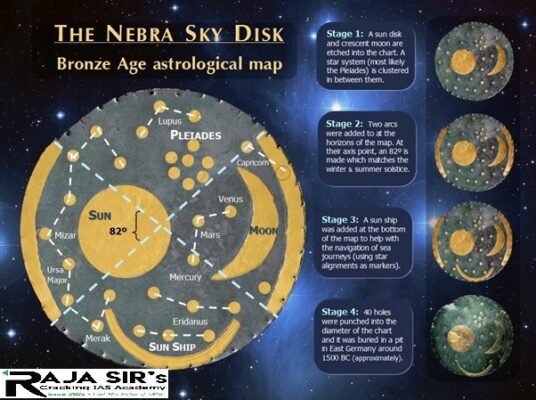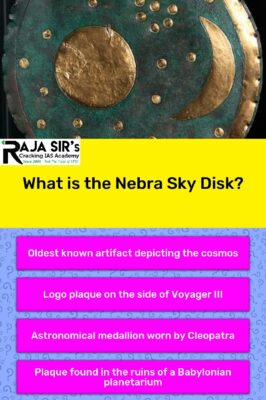- Home
- Prelims
- Mains
- Current Affairs
- Study Materials
- Test Series
23rd Oct 2021
THIS INTERNATIONAL E-WASTE DAY, GIVE YOUR USED ELECTRONIC DEVICES FOR RECYCLING, URGES NON-PROFIT
International E-Waste Day is observed on October 14 every year since 2018.







 Minister of Commerce & Industry concludes his two-day visit as part of the public outreach programme of the central government inaugurated 250mm Seer Water supply scheme in Kashmir.
Minister of Commerce & Industry concludes his two-day visit as part of the public outreach programme of the central government inaugurated 250mm Seer Water supply scheme in Kashmir.
- It was developed in 2018 by the Waste Electronic and Electrical Equipment (WEEE) Forum.

- The weight of e-waste generated in 2021 surpasses that of China’s Great Wall.
- WEEE in 2021 is about 57.4 million tonnes (MT), compared to that of 53.6 MT in 2019 and is predicted to reach 74 MT by 2030.
- Growing consumption of electronics, smaller periods between new product releases and limited options for repairing broken items are some major reasons attributed to this growth.
- India has become the third largest producer of e-waste after China and the United States, producing over 3.23 million metric tonnes of e-waste per year.
- More than 95 per cent of this waste is handled by the informal sector.
- Less than 5% of e-waste in India is recycled through formally regulated units through hazardous and unsafe practices such as open-air incineration and acid leaching.
- Government and industry sectors generate more than 70% of e-waste, while households contribute around 15%.
- The first policy effort towards addressing e-waste was the 2008 Guidelines for environmentally sound management of e-waste.
- In 2011, the Indian government established the E-Waste (Handling and Management) Rules, which was subsequently replaced by the revised E-waste (Management) Rules of 2016.

- Outlines the procedures for producers/manufacturers, dealers, recyclers, and dismantlers to obtain authorization from relevant government agencies and administrative bodies to manage e-waste.
- Mandates the Extended Producer Responsibility (EPR) mechanism.
- Introduces a Deposit Refund Scheme which allows producers to charge a deposit fee when selling a product and refunding the amount, along with interest earned, when the consumer returns it at the end of its lifecycle.
- Relatively weak in term of ensuring compliance.
- They do not specify the penalties imposed on EPR defaulters, or on consumers who do not dispose e-waste at dedicated recycling centers.
- It fails to directly address the major role played by informal sector workers in handling and recycling e-waste.
- The major challenge for India’s policy makers is to improve the effectiveness of e-waste management and reduce associated environmental and health risks in cities and communities. The other major challenges are:
- Lack of market information and financial incentives.
- Public awareness of e-waste hazards and recycling is low.
- The majority of individual and urban household consumers sell their waste to kabadiwalas or get some discount in exchange.
- Poor infrastructure for enabling industrial-scale recovery and recycling of e-waste.
- Formal sector recycling is limited to manual sorting and mechanical dismantling of e-waste.
- Shortage of formally approved e-waste recycling centers.
- The currently existing centers operate far below their capacity due to poorly organized supply chains between them and the majority of informal sector collectors of e-waste.
- Providing market information regarding e-waste prices
- Incentivizing e-waste recycling
- Upskilling informal sector players
- Deploying readily available and mature recycling technologies
- Developing innovative methods and technologies for processing new forms of e-waste.
- Basel Convention started to address e-waste issues since 2002 which include:
- Environmentally sound management
- Prevention of illegal traffic to developing countries
- Building capacity around the globe to better manage e-waste.
- Australia has considerable expertise in e-waste policymaking and management. Australian industries and researchers could also collaborate with their Indian counterparts on joint research projects to test and further develop innovative technologies.

- The Kosi river, which runs on the eastern periphery of the Jim Corbett National Park, overflowed its banks due to extreme rainfall in its catchment areas, endangering iconic wildlife and stranding tourists in forest resorts.
- The overflow was due to a cloudburst triggered flash flood at Ramgarh in Uttarakhand’s Nainital district, upstream of the National Park.
- Kosi is a Himalayan River which originates from Dharpani Dhar (2,500 m) in Baramandal region of Almora district, Uttarakhand.
- The 168 kms long river flows through the Uttarakhand, then it enters the Tarai regions of Uttar Pradesh, where it joins Ramganga river.
- The water of this river for cultivating of wheat, rice and other crops.
- Koshi Barrage, also called Bhimnagar Barrage, was built between 1959 and 1963 and straddles the Indo-Nepal border.
- It is an irrigation, flood control and hydropower generation project on the Kosi River built under a bilateral agreement between Nepal and India.
- Sapta Koshi High Dam Multipurpose Project and Sun Kosi Storage-cum-Diversion Scheme to meet the objectives of India and Nepal for development of hydropower, irrigation, flood control and management and navigation.
- Located in the Nainital district of Uttarakhand state.
- It was established in 1936 during the British Raj as the first national park in India, and named Hailey National Park after William Malcolm Hailey, a governor of the United Province.
- It was renamed Corbett National Park after the hunter and naturalist Jim Corbett, who had played a leading role in its establishment.
- The Park was the first to come under the Project Tiger initiative.
- Forest covers almost 73% of the park, while 10% of the area consists of grasslands.
- It protects parts of the Upper Gangetic Plains moist deciduous forests and Himalayan subtropical pine forests ecoregions.
- It has a humid subtropical and highland climate.
- Fauna: Tiger, leopards, elephants, spotted deer, barking deer, hog deer, wild boar, porcupines, sloth bear, nilgai, chital and sambhar, crocodile, gharial etc.
- Flora: Sal wood, Khair, sissoo, shisham, bakli, pula, kharpat, chir pine, oak, Bel, kusum, mahua, bamboos, grasses, climbers and herbs.
- The intention is to hold an in-person meeting of the ministers in the coming months at ‘Expo 2020’ in Dubai.
- The four leaders also exchanged views on shared issues of concern in the region and the importance of expanding economic and political collaboration.
- They decided together to establish an international forum for economic cooperation.
- They discussed joint infrastructure projects in transportation, technology, maritime security, and economics and trade, as well as additional joint projects.
- To expand economic and political cooperation in the Middle East and Asia and to enhance maritime security.
- It was decided that each minister will appoint senior-level professionals to a joint working group that will formulate options for cooperation in the areas identified by the ministers.
- The synergy between the four countries will help them work together on infrastructure, transport, maritime security and other issues.
- India, Israel and the UAE have already stepped-up trilateral cooperation, especially in trade and investment, since the US brokered the Abraham Accords in August 2020.
- The meeting focused on ways to expand economic and political cooperation in the Middle East and Asia and to enhance maritime security.
- Joint infrastructure projects in transportation, technology, Big Data, maritime security, and economics and trade, as well as additional joint projects were discussed.
- They also discussed people-to-people ties in technology and science, and ways to support global public health in the context of the Covid-19 pandemic.
- The objective of the forum is to create synergies that go beyond government level cooperation and enter business to business cooperation.
- Each country would appoint a senior level bureaucrat to be part of a joint working group to materialize the decisions taken at the ministerial level.
- It will be balancing act for India to protect its economic and political interests amidst the various fissures of the region over the decades.
- India has robust defence, security and trade cooperation with Israel and the US, while the UAE is a key energy partner, hence such multilateral international cooperation will further cement India’s relation with these countries.
- The forum will act as a platform for exchange of knowledge and experience.
- This cooperation will be manifestation of India’s support and effort to maintain peace and stability in West Asia.
- It belongs to Germany's State Museum of Prehistory in Halle but is being loaned to the British Museum (abroad) for the first time in 15 years.

- The Nebra Sky Disc is widely believed to be 3600 years old, dating from the Bronze Age.
- It is one of the oldest surviving representations of the cosmos in the world.
- The bronze disc was unearthed in Germany in 1999 and is considered one of the most important archaeological finds of the 20th Century.
- The disc was ritually buried along with two swords, axes, two spiral arm-rings and one bronze chisel near Nebra in Germany.
- The Nebra disc measures about 30cm in diameter and has a blue-green patina emblazoned with gold symbols representing the Sun, Moon, stars, solstices and other cosmic phenomena.
- The original purpose of Stonehenge remains a mystery, but the stone circle built in about 2,500 BC is aligned with the movements of the Sun.
- The Sun and its solstices are also represented with markings on the Nebra disc - and experts believe the Sun was central to northern European Bronze Age religion.

- It is thought to be associated with the Unetice culture that inhabited parts of Europe around 1600 BC.
- The Unetice culture comprised early Bronze Age communities in central Europe including in Bohemia, Bavaria, southeastern Germany and western Poland.
- Some of the metal artefacts made during this time by communities in the Unetice culture include ogival and triangular daggers with metal hilts, flanged axes, halberds, spiral arm-rings, solid bronze bracelets and varieties of pins.

- The latest La Nina is expected to last through the early spring of February 2022.
- Previous La Ninas occurred during the winter of 2020-2021 and 2017-2018.
- Two La Ninas happening one after the other is referred to as a ‘double-dip’.
- One in 2020 and the second in 2021.
- Both, La Nina, and El Nino are part of the El Nino Southern Oscillation (ENSO) cycle.
- ENSO is characterized by opposing warm and cool phases of oceanic and atmospheric conditions in the tropical Pacific Ocean.
- La Niña is a “cold event” or a weather pattern that occurs in the Pacific Ocean.
- It is caused by an interaction between the Pacific Ocean and the atmosphere.
- In this pattern, strong trade winds blow warm water at the ocean’s surface from South America to Indonesia. As the warm water moves west, cold water from the deep rises to the surface near the coast of South America.
- In the winter of a La Niña year, these winds are much stronger than usual. This makes the water in the Pacific Ocean near the equator a few degrees colder than it usually is.
- Rain clouds normally form over warm ocean water. La Niña blows all of this warm water to the western Pacific.
- This means that places like Indonesia and Australia can get much more rain than usual.
- However, the cold water in the eastern Pacific causes less formation of rain clouds.
- So, places like the southwestern United States can be much drier than usual.
- These changes in the atmosphere can lead to more lightning activity within the Gulf of Mexico and along the Gulf Coast.
- El Niño means Little Boy, or Christ Child in Spanish.
- During El Niño, trade winds weaken. Warm water is pushed back east, toward the west coast of the Americas.
- It can affect the weather significantly. The warmer waters cause the Pacific jet stream to move south of its neutral position.
- It has a strong effect on marine life off the Pacific coast. During normal conditions, upwelling brings water from the depths to the surface, this water is cold and nutrient rich.
- During El Nino, upwelling weakens or stops altogether, without the nutrients from the deep, there are fewer phytoplankton off the coast.
- This affects the species of fish that eat phytoplankton.

- A peculiar astronomical event was spotted in the Sun's Active Region called AR 12257.
- The scientists studied this astronomical event based on the magnetic and coronal images of the Sun.
- The study has shown that active regions on the sun’s surface have twisted magnetic field configuration (measured by the parameter magnetic helicity).
- Active regions where the sign of the helicity (or twist) reverses with time cannot produce coronal mass ejection.
- Active regions which have excess magnetic helicity beyond the threshold result in Coronal Mass Ejection.
- The study can help in predicting a solar flare or a Coronal Mass Ejection (CME) which can help better prepare to deal with a solar flare or to predict space weather.
- Solar flare or CME affect the electrical, and communication systems on Earth and satellite systems and astronauts in space.
- The results of the study are expected to shed light on magnetic field production in stars and planets as well.
- The Sun has a complex magnetic field near its surface that is connected to its hot plasma.
- Sun’s magnetic field changes its configuration continuously as the plasma itself moves around in the magnetic field.
- Active region: Regions on the sun’s surface where magnetic field can erupt out in loops, become twisted, realign its geometry, and release tremendous amounts of energy in the process.
- The light emitted in this process of magnetic field eruption from active region is called solar flares.
- When huge amount of hot gas is released from the active region, with its embedded magnetic field at a high velocity, it is called a Coronal Mass Ejection (CME).
- Some active regions produce solar flares and some produce CMEs.
- CME is the biggest eruptions from the Sun's surface that can contain a billion tons of matter accelerated to several million miles per hour into space.
- CME streams out through the interplanetary medium, impacting any planet or spacecraft in its path.
- When a strong CME blows past the Earth, it can damage the electronics in our satellites and disrupt radio communication networks on Earth.
- The event is planned by Indian Council for Cultural Relations (ICCR), an autonomous body under the Ministry of External Affairs, which deals with policies relating to India's external cultural relations.
- Objective: To give the young leaders a comprehensive idea about India's rich democratic culture.
- It is a program in which we are inviting young leaders below the age of 35 from 75 different democracies.
- These young leaders will be from the ruling party, the opposition party and other key parties as desirable.
- Around 5-7 leaders will be invited in different groups.
- The structure includes countries representing regions and continents like South East Asia and Africa.
- The first batch will include leaders from Bhutan, Sri Lanka, Bangladesh, Japan, Indonesia, Chile and Zambia.
 Minister of Commerce & Industry concludes his two-day visit as part of the public outreach programme of the central government inaugurated 250mm Seer Water supply scheme in Kashmir.
Minister of Commerce & Industry concludes his two-day visit as part of the public outreach programme of the central government inaugurated 250mm Seer Water supply scheme in Kashmir.
- The project will benefit around 10000 people and will be completed under the ambit of Jal Jeevan Mission within three months.
- The scheme will work towards realizing the Prime Minister's dream of tap water for all households.









 Latest News
Latest News
 General Studies
General Studies